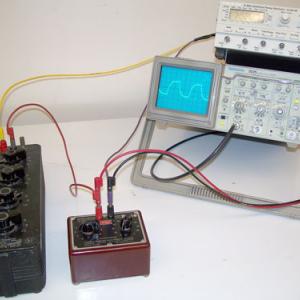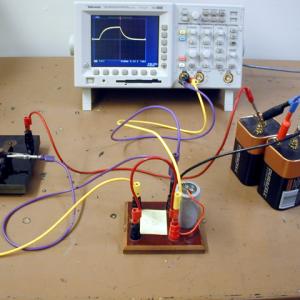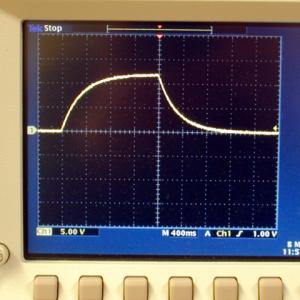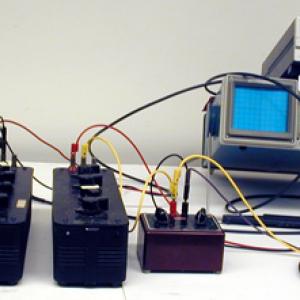College of Liberal Arts & Sciences
5F30.20 - R-C Time Constants
Video Credit: Jonathan M. Sullivan-Wood.
Put the generator, resistor, and capacitor, in series as shown. Set the generator to the square wave function at around 100 Hz. Measure across the capacitor with the oscilloscope. Set the capacitor and resistor to the proper values to obtained the desired trace.
Arrange the circuit as shown. The battery will charge the capacitor when the switch is pressed down. Release the key and the capacitor will discharge through the 1/2 watt, 100 ohm resistor. It is critical to set the scope as shown. The scope setting is stored at #10 in the Recall/Save menu.
The standard oscilloscope will not allow you to observe voltage and current at the same time due to grounding parameters. To get around this drive two identical circuits from the same wave generator with one circuit having the components in reverse order of the other. In this way, the oscilloscope grounding remains valid for both cases and both can be shown on the same scope.
- G. Harvey, M. Gilday, T. J. Kelly, "An Inquiry Approach to Effective Use of Instrumentation: An Example from RC Circuits", TPT, Vol. 60, #3, March 2022, p. 192.
- Rebekah Silar, Michael Glasscock, Brandon Mitchel, Robert Ekey Jr., "A FAN-C Exploration of RC Circuits", TPT, Vol. 58, #8, Nov. 2020, p. 552.
- M. Qasim Syed, Ian Lovatt, "Seeing is Believing: Demonstrating the RC Time Constant Visually", TPT, Vol. 58, #6, Sept. 2020, p. 402.
- Jeffrey R. Groff, "Estimating RC Time Constants Using Sound", TPT, Vol. 57, #6, Sept. 2019, p. 393.
- A. A. Moya, "Connecting Time and Frequency in the RC Circuit", TPT, Vol. 55, #4, Apr. 2017, p. 228.
- Calin Galeriu, Cheryl Letson, and Geoffrey Esper, "An Arduino Investigation of the RC Circuit", TPT, Vol. 53, #5, May 2015, p. 285.
- Fabio M. S. Lima, "A Better Criterion for the Discharging Time in a RC Circuit", TPT, Vol. 53, #1, Jan. 2015, p. 44.
- Biswajit Ray, "When Is a Capacitor NOT a Capacitor?", TPT, Vol. 44, #2, Feb. 2006, p. 106.
- Francis X. Hart, "Computer-Based Experiments to Measure RC", TPT, Vol. 38, #3, Mar. 2000, p. 176.
- Matthew J. Moelter and Rand S. Worland, "A Child's Flashlight and RC Circuit Concepts", TPT, Vol. 35, #1, Feb. 1997, p. 92.
- Jim Oliver, "Observing Voltage Phases in RC, RL, and RLC Circuits", TPT Vol. 35, #1, Jan. 1997, p. 30.
- John G. King and A. P. French, "Using a Multimeter to Study an RC Circuit", TPT, Vol. 33, #3, Mar. 1995, p. 188.
- Thomas A. Walkiewicz and James R. Kirk, "Characteristic Curves", TPT, Vol. 32, #2, Feb. 1994, p. 90.
- Takao Tekeuchi, "It All Adds Up", TPT, Vol. 31, #9, Dec. 1993, p. 518.
- Herbert T. Wood, "The RC Circuit - A Multipurpose Laboratory Experiment", TPT, Vol. 31, #6, Sept. 1993, p. 372.
- John B. Kwasnoski, "Measuring the Charge Stored on a Capacitor", TPT, Vol. 25, #8, Nov. 1987, p. 492.
- J. E. Gordon and P. R. Grant, "Series RC Circuits Revisited", AJP, Vol. 72, #5, May 2004, p. 655.
- Norris W. Preyer, "Transient Behavior of Simple RC Circuits", AJP, Vol. 70, #12, Dec. 2002, p. 1187.
- David E. Wilson, "A Direct Laboratory Approach to the Study of Capacitors", AJP, Vol. 57, #7, July 1989, p. 630.
- Ronald Newburgh, "Two Theorems on Dissipative Energy Losses in Capacitor Systems", Physics Education, Vol. 40 #4, July 2005, p. 370.
- "E-405. Chg. and Dischg. - Square Wave", DICK and RAE Physics Demo Notebook.
- G. D. Freier and F. J. Anderson, "Eo-12", A Demonstration Handbook for Physics.
- G. D. Freier and F. J. Anderson, "En-11", A Demonstration Handbook for Physics.
- G. D. Freier and F. J. Anderson, "En-10", A Demonstration Handbook for Physics.
- G. D. Freier and F. J. Anderson, "En-8", A Demonstration Handbook for Physics.
- Yaakov Kraftmakher, "1.3. Charging and Discharging a Capacitor", Experiments and Demonstrations in Physics, ISBN 981-256-602-3, p. 15.
- Robert Ehrlich, "L.9. Discharging a Capacitor Through a Voltmeter", Turning the World Inside Out and 174 Other Simple Physics Demonstrations, p. 151 - 152.
Disclaimer: These demonstrations are provided only for illustrative use by persons affiliated with The University of Iowa and only under the direction of a trained instructor or physicist. The University of Iowa is not responsible for demonstrations performed by those using their own equipment or who choose to use this reference material for their own purpose. The demonstrations included here are within the public domain and can be found in materials contained in libraries, bookstores, and through electronic sources. Performing all or any portion of any of these demonstrations, with or without revisions not depicted here entails inherent risks. These risks include, without limitation, bodily injury (and possibly death), including risks to health that may be temporary or permanent and that may exacerbate a pre-existing medical condition; and property loss or damage. Anyone performing any part of these demonstrations, even with revisions, knowingly and voluntarily assumes all risks associated with them.




